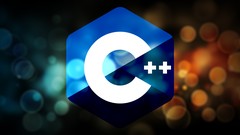Design Patterns in Modern C++
Created By 1
Discover the modern implementation of design patterns with С++
Created By 1
English


Discover the modern implementation of design patterns with С++
Created By 1
English
Introduction
Overview
Single Responsibility Principle
Open-Closed Principle
Liskov Substitution Principle
Interface Segregation Principle
Dependency Inversion Principle
Summary
Gamma Categorization
Overview
Life Without Builders
Builder
Fluent Builder
Groovy-Style Builder
Builder Facets
Summary
Overview
Point Example
Factory Method
Factory
Inner Factory
Abstract Factory
Functional Factory
Summary
Overview
Record Keeping
Prototype
Prototype Factory
Prototype via Serialization
Summary
Overview
Singleton Implementation
Testability Issues
Singleton in Dependency Injection
Singleton Lifetime in DI Container
Monostate
Multiton
Summary
Overview
Vector/Raster Demo
Adapter Caching
Summary
Overview
Pimpl Idiom
Shrink-Wrapped Pimpl
Bridge Implementation
Summary
Overview
Geometric Shapes
Neural NetworksArray-Backed Properties
Array-Backed Properties
Summary
Overview
Dynamic Decorator
Static Decorator
Functional Decorator
Summary
NA
Course Overview
This course provides a comprehensive overview of Design Patterns in Modern C++ from a practical perspective. This course in particular covers patterns with the use of:
This course provides an overview of all the Gang of Four (GoF) design patterns as outlined in their seminal book, together with modern-day variations, adjustments, discussions of intrinsic use of patterns in the language.
What are Design Patterns?
Design Patterns are reusable solutions to common programming problems. They were popularized with the 1994 book Design Patterns: Elements of Reusable Object-Oriented Software by Erich Gamma, John Vlissides, Ralph Johnson and Richard Helm (who are commonly known as a Gang of Four, hence the GoF acronym).
The original book was written using C++ and Smalltalk as examples, but since then, design patterns have been adapted to every programming language imaginable: Swift, C#, Java, PHP and even programming languages that aren't strictly object-oriented, such as JavaScript.
The appeal of design patterns is immortal: we see them in libraries, some of them are intrinsic in programming languages, and you probably use them on a daily basis even if you don't realize they are there.
What Patterns Does This Course Cover?
This course covers all the GoF design patterns. In fact, here's the full list of what is covered:
Who Is the Course For?
This course is for C++ developers who want to see not just textbook examples of design patterns, but also the different variations and tricks that can be applied to implement design patterns in a modern way.
Presentation Style
This course is presented as a (very large) series of live demonstrations being done in JetBrains CLion. Most demos are single-file, so you can download the file attached to the lesson and run it in CLion, XCode or another IDE of your choice (or just on the command line).
This course does not use UML class diagrams; all of demos are live coding.
Dmitri is a quant, developer, book author and course author. His interests lie in software development and integration practices in the areas of computation, quantitative finance and algorithmic trading. His technological interests include C# and C++ programming as well high-performance computing using technologies such as CUDA and FPGAs. He has been a C# MVP since 2009